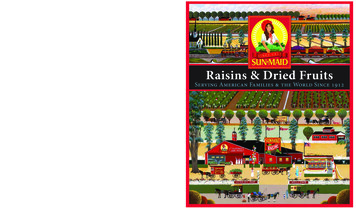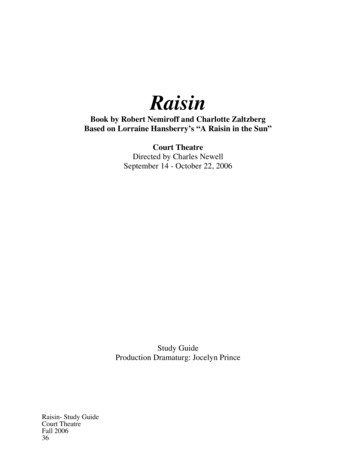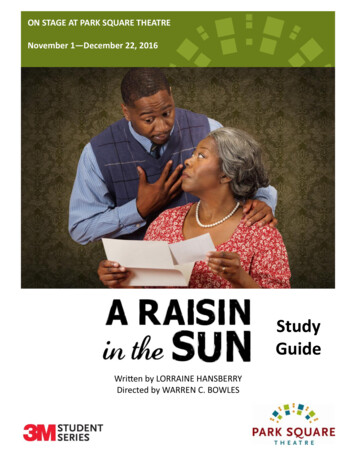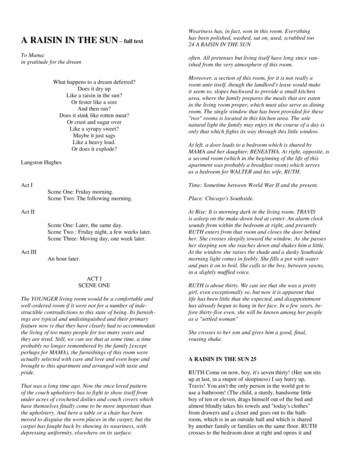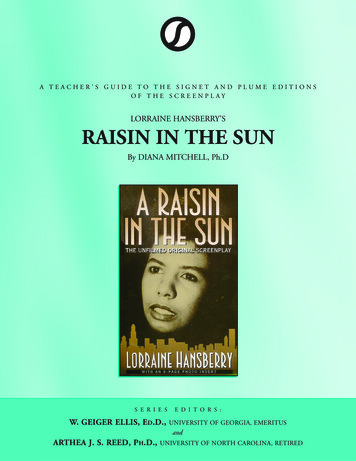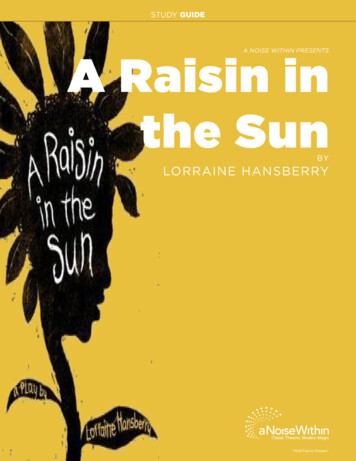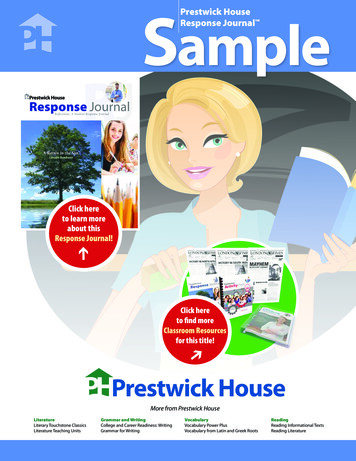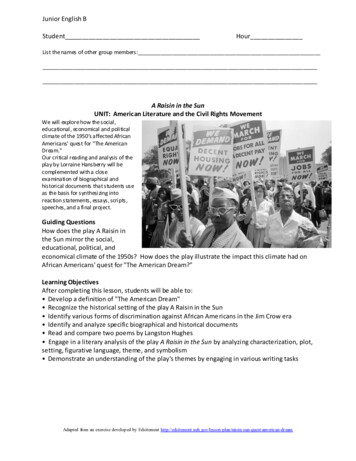
Transcription
Junior English BStudentHourList the names of other group members:A Raisin in the SunUNIT: American Literature and the Civil Rights MovementWe will explore how the social,educational, economical and politicalclimate of the 1950’s affected AfricanAmericans' quest for "The AmericanDream."Our critical reading and analysis of theplay by Lorraine Hansberry will becomplemented with a closeexamination of biographical andhistorical documents that students useas the basis for synthesizing intoreaction statements, essays, scripts,speeches, and a final project.Guiding QuestionsHow does the play A Raisin inthe Sun mirror the social,educational, political, andeconomical climate of the 1950s? How does the play illustrate the impact this climate had onAfrican Americans' quest for "The American Dream?"Learning ObjectivesAfter completing this lesson, students will be able to: Develop a definition of "The American Dream" Recognize the historical setting of the play A Raisin in the Sun Identify various forms of discrimination against African Americans in the Jim Crow era Identify and analyze specific biographical and historical documents Read and compare two poems by Langston Hughes Engage in a literary analysis of the play A Raisin in the Sun by analyzing characterization, plot,setting, figurative language, theme, and symbolism Demonstrate an understanding of the play's themes by engaging in various writing tasksAdapted from an exercise developed by Edsitement uest-am erican-dream
Day 1: Read these two poems by Langston Hughes and make connections to your ownexperiences.“I, too, sing America”I, too, sing America.I am the darker brother.They send me to eat in the kitchenWhen company comes,But I laugh,And eat well,And grow strong.Tomorrow,I'll be at the tableWhen company comes.Nobody'll dareSay to me,"Eat in the kitchen,"Then.Besides,They'll see how beautiful I amAnd be ashamed I, too, am America.-Langston Hughes, 1925"Harlem"What happens to a dream deferred?Does it dry uplike a raisin in the sun?Or fester like a sore And then run?Does it stink like rotten meat?Or crust and sugar over like a syrupy sweet?Maybe it just sagslike a heavy load.Or does it explode?- Langston Hughes, 1951What is the purpose of a preface?Why do you think Hansberry chose thispoem as her preface?What central question does the poemask?Use the Figurative Language Chart (available asa downloadable PDF file) to analyze the similesand metaphors in the poem. Discuss responsesto the Figurative Language Chart .Although the poem is phrased as a list ofquestions, Hughes is making a statement.What is Hughes' message about dreamsdeferred?How do "dreams deferred" relate tothe American Dream?Watch the video clip “Dream vspot/video/hughes.htmlAdapted from an exercise developed by Edsitement uest-am erican-dream
Days 2,3,4: Students will work in small groups of three (assigned) to investigate photographs, videos,recordings, and documents from the 1950’s. Although time will be limited, if your group focuses on thetask, together you should cover most of the material listed below. As you begin your investigation, eachgroup should split up the list of 18 sources and assign each group member certain sources to review. Inorder for your group to receive at least a "B" grade for days 2, 3,and 4, your group must complete EACHof the analysis forms: 2 Written Document Analysis worksheets, 4 Photo Analysis worksheets, 2 SoundRecording Analysis worksheets, 1 Motion Picture (Video Clip) Analysis worksheet, and 1 Map Analysisworksheet.Assigned Internet Links:Source #1 Academy of American Poets(http://www.poets.org/index.cfm)Source #2 Langston Hughes, "Let America Be America Again"(http://www.poets.org/poems/poems.cfm?prmID 1473)Source #3 Africans in America (http://www.pbs.org/wgbh/aia)Source #4 Jim Crow-Close UpSource #5 American Memory Collection: (http://memory.loc.gov)Source #6 African American Odyssey: The Civil Rights part9.html]Source #7 Daisy Bates and the Little Rock Nine Letter "Dark Laughter"Source #8 Equality of Treatment and Opportunity in the Armed ForcesSource #9 Montgomery Bus BoycottSource #10 Saving the RaceSource #11 The Genesis of Racial Identification and Preferences in Negro ChildrenSource #12 African American Perspectives: Progress of a l]Source #13 Protection of American Citizens: Pamphlet—"The Black Laws" by Bishop B.W. l]Source #14 Mob-Violence and Anarchy, North and South: Pamphlet—"Lynch Laws in Georgia" by Ida pmob.html]Digital Classroom (National Archives and Records Administration)(http://www.archives.gov/digital classroom/index.html)Document Analysis Worksheets(http://www.archives.gov/digital classroom/lessons/analysis worksheets/worksheets.html)Written Document(http://www.archives.gov/digital classroom/lessons/analysis worksheets/document.html )Adapted from an exercise developed by Edsitement uest-am erican-dream
Photograph Analysis Worksheet(http://www.archives.gov/digital classroom/lessons/analysis worksheets/photo.html)Source #15 Documents Related to Brown V. Board of Education(http://www.archives.gov/digital classroom/lessons/brown v board documents/brown v board.html)Learner.org [http://www.learner.org/exhibits/]Source #16 Montage of a Dream /chap9/Hughes.html]Source #17 Audio-clip of a Dream pot/video/hughes.html]Perseus Project (http://www.perseus.tufts.edu)Source # 18 Perseus Encyclopedia(http://www.perseus.tufts.edu/cgi -bin/ptext?doc 1999.04.0004)Source #19 We Shall Overcome: Historic Places of the Civil Rights MovementAdapted from an exercise developed by Edsitement uest-am erican-dream
Adapted from an exercise developed by Edsitement uest-am erican-dream
Adapted from an exercise developed by Edsitement uest-am erican-dream
Adapted from an exercise developed by Edsitement uest-am erican-dream
Adapted from an exercise developed by Edsitement uest-am erican-dream
Adapted from an exercise developed by Edsitement uest-am erican-dream
Adapted from an exercise developed by Edsitement uest-am erican-dream
Adapted from an exercise developed by Edsitement uest-am erican-dream
Adapted from an exercise developed by Edsitement uest-am erican-dream
Adapted from an exercise developed by Edsitement uest-am erican-dream
Adapted from an exercise developed by Edsitement uest-am erican-dream
Adapted from an exercise developed by Edsitement uest-am erican-dream
Adapted from an exercise developed by Edsitement uest-am erican-dream
Adapted from an exercise developed by Edsitement uest-am erican-dream
Adapted from an exercise developed by Edsitement uest-am erican-dream
Day 5: Before we begin the drama, students will participate in small group discussions toexplore the following questions:1. Why do people from other countries immigrate to America?2. When we talk about "The American Dream", what do we mean? What are some of theobstacles to achieving the American Dream?3. Which groups of people have had trouble attaining "The American Dream"? There are avariety of acceptable responses to this question. E.g. Native Americans, Irish Americans,African Americans, Chinese Americans, and Japanese Americans, as well as the poor andwomen.4. Given the obstacles that some Americans have to overcome, what makes the AmericanDream appealing?Day 6:We will read together Langston Hughes’ poem “Let America Be America Again.”Let America Be America Againby Langston HughesLet America be America again.Let it be the dream it used to be.Let it be the pioneer on the plainSeeking a home where he himself is free.(America never was America to me.)Let America be the dream the dreamers dreamed-Let it be that great strong land of loveWhere never kings connive nor tyrants schemeThat any man be crushed by one above.(It never was America to me.)O, let my land be a land where LibertyIs crowned with no false patriotic wreath,But opportunity is real, and life is free,Equality is in the air we breathe.(There's never been equality for me,Nor freedom in this "homeland of the free.")Say, who are you that mumbles in the dark?And who are you that draws your veil across the stars?I am the poor white, fooled and pushed apart,I am the Negro bearing slavery's scars.I am the red man driven from the land,Adapted from an exercise developed by Edsitement uest-am erican-dream
I am the immigrant clutching the hope I seek-And finding only the same old stupid planOf dog eat dog, of mighty crush the weak.I am the young man, full of strength and hope,Tangled in that ancient endless chainOf profit, power, gain, of grab the land!Of grab the gold! Of grab the ways of satisfying need!Of work the men! Of take the pay!Of owning everything for one's own greed!I am the farmer, bondsman to the soil.I am the worker sold to the machine.I am the Negro, servant to you all.I am the people, humble, hungry, mean-Hungry yet today despite the dream.Beaten yet today--O, Pioneers!I am the man who never got ahead,The poorest worker bartered through the years.Yet I'm the one who dreamt our basic dreamIn the Old World while still a serf of kings,Who dreamt a dream so strong, so brave, so true,That even yet its mighty daring singsIn every brick and stone, in every furrow turnedThat's made America the land it has become.O, I'm the man who sailed those early seasIn search of what I meant to be my home-For I'm the one who left dark Ireland's shore,And Poland's plain, and England's grassy lea,And torn from Black Africa's strand I cameTo build a "homeland of the free."The free?Who said the free? Not me?Surely not me? The millions on relief today?The millions shot down when we strike?The millions who have nothing for our pay?For all the dreams we've dreamedAnd all the songs we've sungAnd all the hopes we've heldAnd all the flags we've hung,The millions who have nothing for our pay-Except the dream that's almost dead today.O, let America be America again-The land that never has been yet-And yet must be--the land where every man is free.The land that's mine--the poor man's, Indian's, Negro's, ME-Who made America,Whose sweat and blood, whose faith and pain,Adapted from an exercise developed by Edsitement uest-am erican-dream
Whose hand at the foundry, whose plow in the rain,Must bring back our mighty dream again.Sure, call me any ugly name you choose-The steel of freedom does not stain.From those who live like leeches on the people's lives,We must take back our land again,America!O, yes,I say it plain,America never was America to me,And yet I swear this oath-America will be!Out of the rack and ruin of our gangster death,The rape and rot of graft, and stealth, and lies,We, the people, must redeemThe land, the mines, the plants, the rivers.The mountains and the endless plain-All, all the stretch of these great green states -And make America again!Day 7: Following the four class periods of small group investigation and discussion, each groupwill formulate one definition of “The American Dream.” The definition should be written in thestyle of a dictionary definition. Give a literal meaning of the term. Then, give cultural contexts(what do specific American cultures- Jewish, Japanese, African American, Mexican, etc.- view asan American dream?) At the end of your definition, include antonyms.Each group will share its definition with the class.Please construct your definition on the next page.Adapted from an exercise developed by Edsitement uest-am erican-dream
Our group's definition:Cultural contexts: (example, for Japanese Americans, this means )Antonyms:Adapted from an exercise developed by Edsitement uest-am erican-dream
Jun 07, 2016 · Engage in a literary analysis of the play A Raisin in the Sun by analyzing characterization, plot, setting, figurative language, theme, and symbolism Demonstrate an understanding
